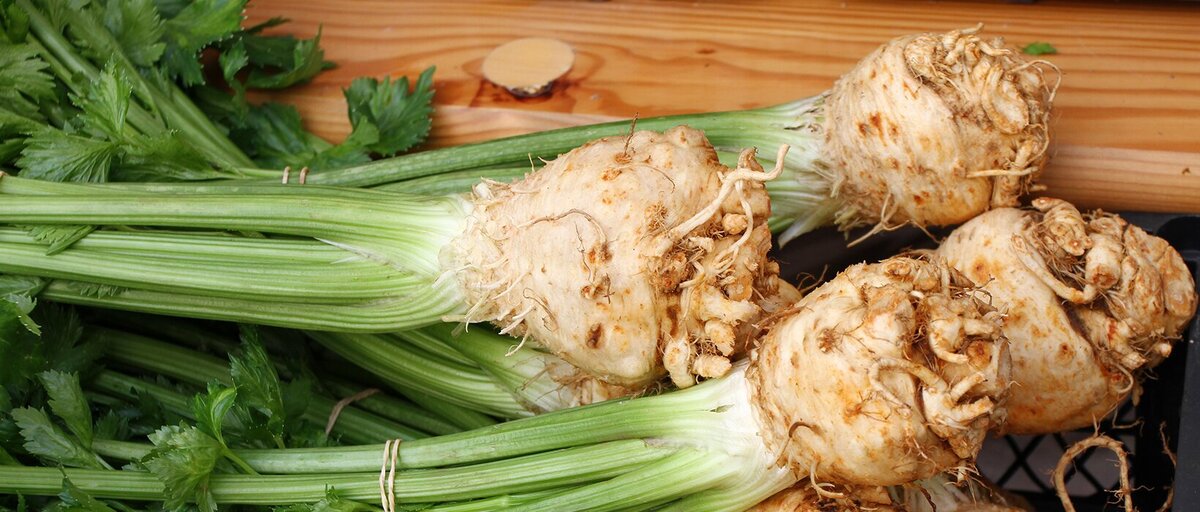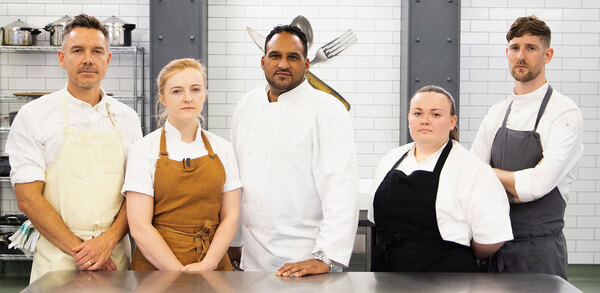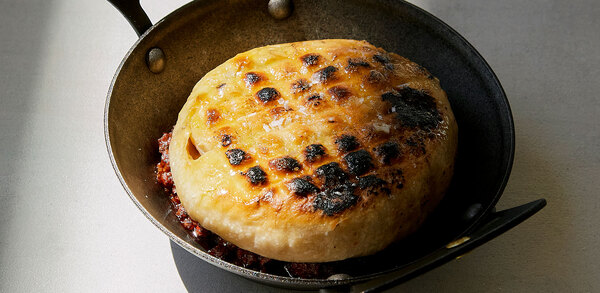11 ways to cook celeriac by Sat Bains
In its raw state, celeriac won't win any beauty contests, but Sat Bains has devised 11 ways to transform it into the belle of the ball
As a raw material, celeriac doesn't look promising. It makes a nice purée. It gives a kick to a split pea soup. It's the basis of the classic celery rémoulade salad. Beyond these go-to recipes, few would give it a second glance, or a second chance.
However, in the hands of a creative chef it can take on a new identity. The bulbous, ugly sister of celery can turn into the belle of the vegetable ball. It's not something that happens by waving a wand. Sat Bains may have the magic touch, but giving celeriac an effective makeover takes time. There's a process involved, starting with an idea that, perhaps months later, will result in a dish that he's happy to serve his customers.
What is celeriac
Most of us think of celeriac as a root vegetable. According to the Royal Horticultural Society it's a type of celery that "produces a knobbly, swollen 'bulb' at the base of the stem". Each one can weigh upwards of 400g.
Knowing a little of its history helps to explain its taste. Wild celery as a foodstuff goes back to the Ancient Greeks, who used the seeds as a condiment. Its base was a delicacy in Arabic cuisine because of its sweeter taste. Gardeners have cultivated celeriac, the bulb/root variety, for over 400 years. It's fleshy and full bodied, but on the downside, it takes a lot of peeling and discolours rapidly.
What does celeriac taste like?
Working with celeriac in an inventive way is about breaking boundaries. Carrots are vegetables, but few people have a problem with carrot cake. Beetroot jellies are already a petit four cliche, as is chilli-flavoured chocolate truffle. The skill lies in the delivery and the dosage.
A Sat Bains tasting menu (seven or 10 courses) isn't a collection of individual dishes borrowed from the a la carte. It's a composition with its own rhythm and balance. The celery hit in a taster or an early course will be different from that in a pre-dessert or dessert.
In one of his early menus he did a take on a Waldorf salad before the main course that combined a celery panna cotta, walnut nougatine and apple-juice-infused sultanas. This evolved into a later dish where he added a celery granita.
If the taste works with celery in one context, it provides a precedent for developing related recipes with celeriac. A chef has to take a further imaginative step to visualise it as an out-and-out dessert. Look closely and it ticks a number of boxes. It's sweet, it's lightly perfumed and its texture can be anything from a coulis to a candied fruit.
How does Sat Bains cook celeriac?
Two-Michelin-starred chef Sat Bains chose celeriac to show off his approach to developing new dishes because, he says: "It's a pretty ugly vegetable that can be so beautiful. Inside its knobbly outer layer, it can be gold."
The boundaries between what should be sweet and what should be savoury are arbitrary. Whenever he looks at an ingredient he tries to approach it as if he were seeing it for the first time. Rather than going to a book or the internet for inspiration, he would rather apply techniques at his fingertips to an ingredient that reflect his personal response to it. If this seems a random or improvised way of cooking it isn't. He still keeps the notebooks of sketches and ideas that have been a personal trademark, but the journey from a diagram, or sentence scribbled on a blank page to a dish he's happy to serve customers is more demanding.
"We've done tasting menus for the past 13 years," he says, "and I want to be good at it. Our theory is that you have to see what dishes are on each side for there to be a proper synergy, so there's a real flow."
If people are going to eat seven- or 10-course menus, he argues, they should approach each one with the same vigour. Over time his palette of skills has developed, but he hasn't let his technical armoury take over: "My central idea is that the food a customer gets should taste amazing," he says. "If technique takes over the eating experience becomes hollow."
In 2010, he built a development kitchen so that his ideas and those of his chefs could be followed up in an environment away from the bustle of a working kitchen.
"It's a place where we can discuss openly and without hierarchy a dish, a feeling or a seasoning," says Bains, who develops all his recipes with head chef John Freeman.
Before a dish such as his 'Textures of celeriac' made it onto the menu, it would have undergone months of testing. In turn, it will have evolved from other textures of dishes.
Bains thinks chefs owe it to their customers to master their craft: "We should understand ingredients so well that we give them something that will make them go 'Wow!'" he says.
When he first made his impact on the restaurant scene, he had a special talent for deconstructing familiar dishes and reassembling them in ways that were novel and exciting. A decade on, he has progressed the output from his kitchens to another level. A Sat Bains signature dish may have distant echoes of something his granny may have cooked or that he may have enjoyed in the past. What he will have done to it is unique.
Eleven ways to cook celeriac
1. CELERIAC BREAD AND BUTTER PUDDING (WITH CELERIAC ICE-CREAM)
The moisture is extracted from the celeriac by cooking it in a syrup of a specific density until it becomes almost translucent without hardening.
Cubes of candied celeriac go into individual glass pots. A brioche slice is fitted on top and then the enriched flavoured custard. It's baked at a sub-boiling point temperature and then dusted with sugar and glazed.
2. CELERIAC PARFAIT SANDWICH
Parfait wedged between two crisp sablé sheets with sweetened fruit vinegar and micro leaves.
3. CELERY AND APPLE GRANITA
Pour liquid nitrogen into a mixing bowl with a whisk attachment. Whisk in apple juice and celery juice plus a little double cream.
When the granita has the texture of hailstones, spoon it over the baked celeriac
5. CHOCOLATE CAKE WITH CELERIAC PANNA COTTA
A layer of semi-freddo panna cotta on a small macaroon-sized disc of chocolate cake with a little caramel sauce and a hint of freeze-dried Nescafé.
The base is a lozenge of flourless chocolate cake. On top is a disc of celeriac panna cotta (see below).
6. CELERIAC PANNA COTTA
Infuse cubed celeriac in simmering milk for 30 minutes and strain. Add softened gelatine (1 leaf per 100ml of milk).
Combine the flavoured milk with an equal quantity of double cream. Chill rapidly and leave for at least four hours to set. This can be sweetened or not according to the balance of the recipe.
7. CELERIAC IN THE STYLE OF A BACKED BRAMLEY APPLE WITH AN APPLE AND CELERY GRANITA
Serve as a winter dessert. The celeriac is baked, served with its baking sauce and coated with the granita.
8. SWEET AND SALTY BAKED CELERIAC
Prepare a buttery caramel with sultanas. Roll pieces of raw celeriac in demerara.
Put each portion in a small cast iron pot with about 100g of soft caramel and sultanas and bake for about 90 minutes at 140°C, basting regularly.
9. SALT-BAKED CELERIAC
Wash any soil off the celeriac. Mix about 500g coarse salt with fresh thyme, Douglas fir needles and enough egg white to make a loose paste. Coat the celeriac in the salt. Stand it on a tray and bake it in a hot oven for two hours.
To use the celeriac, remove the peel with the salt crust. Cut the celeriac into pieces and blend the trimmings with semi-skimmed milk to make the purée.
10. PICKLED CELERIAC
Marinate celeriac ribbon in a pickle based on 150ml spirit or rice vinegar to 100g white sugar and vac-pack under pressure.
11. CURRIED CELERIAC
Celeriac parfait on a stick. Served as a cross-over course after the main, it's a cylinder of celeriac parfait, coated in a thin layer of white chocolate, dusted in coriander and cumin, then decorated with coloured sugar-coated fennel seeds.
Pairing wine with celeriac
Laurent Richet, master sommelier at Restaurant Sat Bains gives his recommendation:
"For the textures of celeriac dish, I suggest an oaky wine. The best match we have found is a 2008 Vernaccia di San Gimignano Riserva, Panizzi, Tuscany. It's an understated DOCG appellation from Tuscany, and was actually the first one in the whole of Italy to be graded to DOC in 1966. Its overwhelming oaky notes and taste are exactly what's best for the celeriac. Tasting the wine first then tasting it again after a bite of the celeriac, the wine can lose a bit of its oaky character and becomes this incredible match of food and wine. What a beautiful way to reintroduce oaky wine to people when matching with the right food – even better, introducing a mostly unknown/missunderstood appellation."
Image: Shutterstock

















